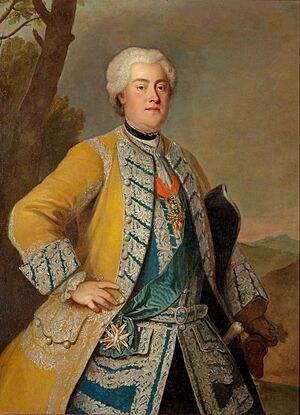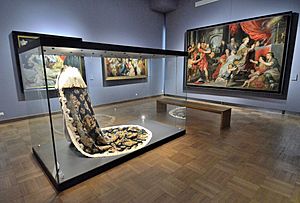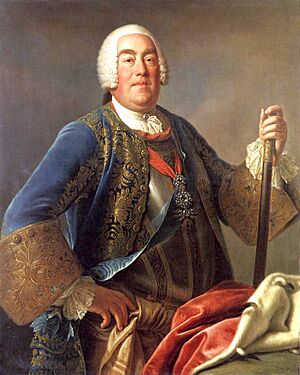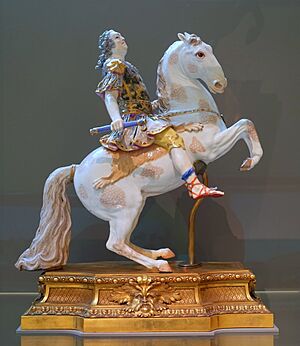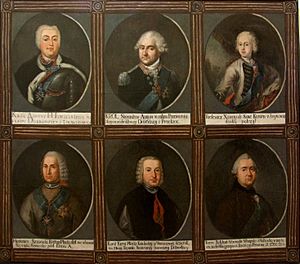Augustus III of Poland facts for kids
Quick facts for kids Augustus III |
|
|---|---|
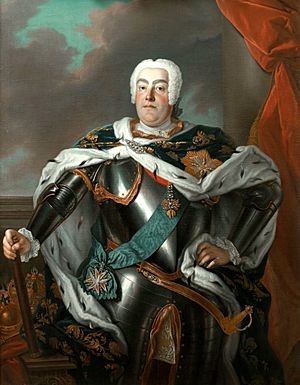
Portrait by Louis de Silvestre
|
|
| King of Poland Grand Duke of Lithuania |
|
| Reign | October 1733 – 5 October 1763 |
| Coronation | 17 January 1734 Wawel Cathedral, Kraków |
| Predecessor | Stanisław I |
| Successor | Stanisław II Augustus |
| Elector of Saxony | |
| Reign | 1 February 1733 – 5 October 1763 |
| Predecessor | Frederick Augustus I |
| Successor | Frederick Christian |
| Born | 17 October 1696 Dresden, Electorate of Saxony |
| Died | 5 October 1763 (aged 66) Dresden, Electorate of Saxony |
| Burial | Dresden Cathedral, Dresden |
| Spouse |
Maria Josepha of Austria
(m. 1719; died 1757) |
| Issue More |
Frederick Christian, Elector of Saxony Maria Amalia, Queen of Spain Maria Anna, Electress of Bavaria Prince Francis Xavier of Saxony Maria Josepha, Dauphine of France Charles, Duke of Courland Maria Christina, Abbess of Remiremont Princess Maria Elisabeth Albert Casimir, Duke of Teschen Clemens Wenceslaus, Archbishop-Elector of Trier Maria Kunigunde, Abbess of Essen |
| House | Wettin |
| Father | Augustus II of Poland |
| Mother | Christiane Eberhardine of Brandenburg-Bayreuth |
| Religion | Roman Catholic (since 1712) Lutheran (until 1712) |
| Signature |  |
Augustus III (born October 17, 1696 – died October 5, 1763) was the King of Poland and Grand Duke of Lithuania from 1733 to 1763. He was also the Elector of Saxony in the Holy Roman Empire, where he was known as Frederick Augustus II.
He was the only legal son of Augustus II the Strong. Augustus III changed his religion to Roman Catholicism in 1712. This was done to help him become king of Poland. In 1719, he married Maria Josepha, who was the daughter of Joseph I, Holy Roman Emperor. Augustus became Elector of Saxony after his father died in 1733. He became King of Poland on October 5, 1733, and was crowned in Kraków on January 17, 1734.
During his rule, Augustus III supported Austria against Prussia in two major wars: the War of the Austrian Succession (1742) and the Seven Years' War (1756). Both wars led to Saxony being defeated and taken over by Prussia. In Poland, his rule saw more power for the Czartoryski and Poniatowski families. It also saw Catherine the Great of Russia getting involved in Polish matters. Augustus III was more interested in his hobbies than in running the country. He let his main advisor, Heinrich von Brühl, manage Saxony and Poland.
Contents
Augustus III: King of Poland and Elector of Saxony
Early Life and Education

Augustus was born on October 17, 1696, in Dresden. He was the only legal son of Augustus II the Strong, who was the Prince-Elector of Saxony and ruler of the Polish–Lithuanian Commonwealth. His mother was Christiane Eberhardine of Brandenburg-Bayreuth. Unlike his father, his mother remained a strong Protestant her whole life. She never went to Catholic Poland during her 30 years as queen.
Augustus was prepared from a young age to become king of Poland-Lithuania. He had the best teachers from all over Europe. He learned Polish, German, French, and Latin. He also studied math, chemistry, and geography. When his father was in Poland, young Augustus stayed with his grandmother, Princess Anna Sophie of Denmark. She raised him as a Lutheran at first. This was a problem for the Poles, who wanted a Catholic king.
To help him become Catholic, Augustus II sent his son on a trip to Catholic countries in Europe. While in Venice, there was an attempt to kidnap him. This was planned by British agents who wanted to stop him from converting. Augustus became a Roman Catholic in November 1712 while traveling in Italy. This was announced publicly in 1717, which made some Protestant nobles in Saxony unhappy.
In 1714, Augustus was welcomed by Louis XIV of France at Versailles. Louis XIV was happy that Augustus had become Catholic. Augustus stayed at the royal court and in Paris. He went to many parties and learned more about French language, politics, and diplomacy. He also traveled across France to see how cities and villages worked. This helped him understand the lives of ordinary people.
Marriage and Family
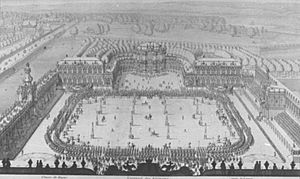
On August 20, 1719, Augustus married Maria Josepha of Austria in Vienna. She was the daughter of Emperor Joseph I. Augustus II had planned this marriage to keep Saxony strong in the Holy Roman Empire. This alliance with Catholic Charles VI would help if there were problems with Protestant states. Maria Josepha had to give up her claim to the Austrian throne before the marriage.

The wedding celebration in Dresden was very grand and expensive. It lasted two weeks, with over 800 guests. The main feast was held in a room made to look like a silver mine. About 4 million thalers were spent on the event.
Becoming King
Augustus II died suddenly on February 1, 1733. Augustus III easily became the Elector of Saxony. But becoming King of Poland was much harder. Before the king died, Prussia, Austria, and Russia signed a treaty. They wanted to stop Augustus III and Stanisław Leszczyński from becoming king of Poland. They wanted a neutral king who would not make Poland stronger.
However, this treaty did not last. Prussia started to support Leszczyński. So, Austria and Russia signed a new treaty in 1733. Russia agreed to send troops to help Augustus III become king. In return, Augustus would recognize Anna Ivanovna as Empress of Russia. Austria got a promise that Augustus would not claim the Austrian throne.
War of the Polish Succession
Augustus faced opposition from Stanisław I Leszczyński. Stanisław had been king before, with support from Sweden. He returned from exile in 1733 with help from Louis XV of France and Spain. This started the War of the Polish Succession.
In August 1733, Russian troops entered Poland to help Augustus become king. Stanisław was chosen by more votes, but Augustus had the support of powerful and wealthy Polish nobles. France and Spain declared war on Austria and Saxony. Most of the fighting happened outside Poland. Russian and Saxon forces chased Stanisław until he was trapped in Gdańsk. Stanisław later fled to France. In 1736, Augustus III was officially confirmed as King of Poland.
The Polish phrase od Sasa do Lasa (from the Saxon to Leszczyński) is still used today. It means describing two completely opposite things.
His Reign and Diplomacy
Poland
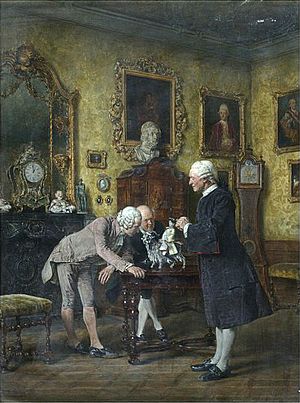
As king, Augustus was not very interested in Poland. He preferred hunting, opera, and collecting art. He spent less than three years of his 30-year reign in Poland. Political fights between powerful families made the Polish parliament (Sejm) weak. This led to disorder and made Poland weaker. Augustus gave most of his power in Poland to Heinrich von Brühl, who acted like a viceroy. Brühl let the most powerful nobles handle Polish politics, which led to a lot of corruption.
Under Augustus, Poland was not involved in any major wars. This made its position in Europe weaker. Neighboring countries took advantage of the disorder. Brühl stopped any opposition using Saxon or Russian forces that were always in Poland.
Brühl was a skilled diplomat. He was also in charge of the Saxon court in Dresden. He loved collecting things like jewelry and Meissen porcelain. His "Swan Service" porcelain set had 2,200 pieces and is considered one of the finest ever made. Brühl was known for his lavish spending.
By 1748, Augustus III finished extending the Saxon Palace in Warsaw. He also helped remodel the Royal Castle. In 1750, Brühl bought a house next to the Saxon Palace and turned it into the beautiful Brühl Palace. Both buildings were destroyed in World War II.
Wars and Challenges
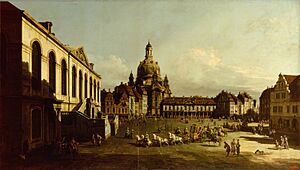
Because he married an Austrian princess, Augustus had to accept her cousin, Maria Theresa, as the Holy Roman Empress. Saxony tried to stay neutral between France and Austria. But between 1741 and 1742, Saxony was allied with France before switching to Austria's side.
In December 1740, Prussia invaded Silesia without declaring war. Silesia was a rich area with many resources. Saxony joined Austria in the Second Silesian War in 1744. Prussia won important battles and occupied Dresden. The Treaty of Dresden in 1745 ended the war. Saxony had to pay a large amount of money to Prussia. This war almost made Saxony go bankrupt.
Saxony was also involved in the Seven Years' War from 1756 to 1763. Saxony was allied with Austria and Russia against Frederick the Great of Prussia. Frederick saw Saxony as a place to expand his territory. On August 29, 1756, the Prussian army invaded Saxony. Saxony was heavily used to support Prussia's war efforts. The Treaty of Hubertusburg in 1763 ended the war with Prussia's victory. Saxony gave up its claim to Silesia.
Death
In April 1763, Augustus returned to Dresden from Poland, feeling sick and weak. He died suddenly on October 5, 1763, in Dresden from a stroke. He was buried at Dresden Cathedral. He is one of the few Polish kings buried outside of Poland.
His oldest living son, Frederick Christian of Saxony, became Elector but died a few months later. In Poland, Stanisław August Poniatowski was elected king in 1764. He was supported by Russia and became King Stanisław II Augustus.
Legacy
Patron of the Arts
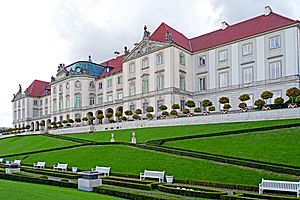
Augustus III loved art and architecture. During his reign, the Catholic Church of the Royal Court was built in Dresden. He greatly expanded the Dresden art gallery. In 1748, he founded the Opera House in Warsaw and the first medical school in Dresden. He also completed the extension of the Saxon Palace in Warsaw and ordered the rebuilding of the eastern side of the Royal Castle. This created the famous Saxon Facade, which is a key part of the Vistula river view of Warsaw Old Town.
In 1733, the famous composer Johann Sebastian Bach dedicated a special Mass to Augustus. Bach hoped to become the Court Composer, a title he received three years later. Augustus III also supported other composers like Johann Adolph Hasse and Johann David Heinichen.
Personal Life
In 1732, the first orphanage in Poland was founded in Warsaw. In 1758, Augustus III ordered that it be called the General Hospital of Infant Jesus. This hospital helped not only orphans but also the sick and the poor. Augustus was a generous man and donated to the hospital throughout his life.
Some people in Poland saw Augustus as a weak king, more interested in comfort than in state affairs. However, historians have found descriptions of Augustus as an honest and caring man. He was respected by both Saxons and Poles. In his personal life, Augustus was a devoted husband to Maria Josepha. They had sixteen children. Like many kings, he enjoyed hunting.
Depictions
Augustus III was played by Ernst Dernburg in the 1941 film Friedemann Bach.
Issue
On August 20, 1719, Augustus married Archduchess Maria Josepha of Austria. She was the oldest child of Joseph I. They had sixteen children, but only fourteen or fifteen are recognized by historians:
- Frederick Augustus Franz Xavier (1720–1721)
- Joseph Augustus Wilhelm Frederick Franz Xavier Johann Nepomuk (1721–1728)
- Frederick Christian Leopold Johann Georg Franz Xavier (1722–1763), who became Elector of Saxony after his father.
- Unknown stillborn daughter (1723)
- Maria Amalia Christina Franziska Xaveria Flora Walburga (1724–1760); married Charles VII, King of Naples, who later became King Charles III of Spain.
- Maria Margaretha Franziska Xaveria (1727–1734), died young.
- Maria Anna Sophie Sabina Angela Franziska Xaveria (1728–1797); married Maximilian III Joseph, Elector of Bavaria.
- Unknown child (1729–1730)
- Franz Xavier Albert August Ludwig Benno (1730–1806), Regent of Saxony (1763–1768).
- Maria Josepha Karolina Eleonore Franziska Xaveria (1731–1767); married Louis, Dauphin of France (1729–1765) (she was the mother of Kings Louis XVI, Louis XVIII and Charles X of France).
- Karl Christian Joseph Ignaz Eugen Franz Xavier (1733–1796), Duke of Courland and Zemgale.
- Maria Christina Anna Teresia Salomea Eulalia Franziska Xaveria (1735–1782), Princess-Abbess of Remiremont.
- Maria Elisabeth Apollonia Casimira Francisca Xaveria (1736–1818), died unmarried.
- Albert Kasimir August Ignaz Pius Franz Xavier (1738–1822), Duke of Teschen.
- Clemens Wenceslaus August Hubertus Franz Xavier (1739–1812), Archbishop of Trier.
- Maria Kunigunde Dorothea Hedwig Franziska Xaveria Florentina (1740–1826), Princess-Abbess of Thorn and Essen.
Gallery
See Also
 In Spanish: Augusto III de Polonia para niños
In Spanish: Augusto III de Polonia para niños
- History of Saxony
- History of Poland (1569–1795)
- Rulers of Saxony
- List of Lithuanian rulers
- Dresden Castle – Residence of Augustus III


